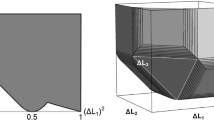Abstract
An extension of the Born rule, the quantum typicality rule, has recently been proposed [B. Galvan in Found. Phys. 37:1540–1562 (2007)]. Roughly speaking, this rule states that if the wave function of a particle is split into non-overlapping wave packets, the particle stays approximately inside the support of one of the wave packets, without jumping to the others.
In this paper a formal definition of this rule is given in terms of imprecise probability. An imprecise probability space is a measurable space \((\varOmega,{\mathcal{A}})\) endowed with a set of probability measures ℘. The quantum formalism and the quantum typicality rule allow us to define a set of probabilities \({\mathcal{P}}_{\varPsi}\) on (X T,ℱ), where X is the configuration space of a quantum system, T is a time interval and ℱ is the σ-algebra generated by the cylinder sets. Thus, it is proposed that a quantum system can be represented as the imprecise stochastic process \((X^{T},{\mathcal{F}},{\mathcal {P}}_{\varPsi})\) , which is a canonical stochastic process in which the single probability measure is replaced by a set of measures. It is argued that this mathematical model, when used to represent macroscopic systems, has sufficient predictive power to explain both the results of the statistical experiments and the quasi-classical structure of the macroscopic evolution.
Similar content being viewed by others
References
Allori, V., Zanghì, N.: What is Bohmian mechanics. Int. J. Theor. Phys. 43, 1743 (2004). arXiv:quant-ph/0112008
Bohm, D., Hiley, B.J., Kaloyerou, P.N.: An ontological basis for the quantum theory. Phys. Rep. 6, 321 (1987)
Dürr, D., Goldstein, S., Zanghì, N.: Quantum equilibrium and the origin of absolute uncertainty. J. Stat. Phys. 67, 843 (1992). arXiv:quant-ph/0308039
Dürr, D., Goldstein, S., Zanghì, N.: Quantum equilibrium and the role of operators as observables in quantum theory. J. Stat. Phys. 116, 959–1055 (2004). arXiv:quant-ph/0308038
Everett, H.: Relative state formulation of quantum mechanics. Rev. Mod. Phys. 29, 454–462 (1957)
Galvan, B.: Typicality vs. probability in trajectory-based formulations of quantum mechanics. Found. Phys. 37, 1540–1562 (2007). arXiv:quant-ph/0605162
Goldstein, S.: Boltzmann’s Approach to Statistical Mechanics. In: Bricmont, J., Dürr, D., Galavotti, M.C., Ghirardi, G., Petruccione, F., Zanghì, N. (eds.) Chance in Physics: Foundations and Perspectives. Lecture Notes in Physics, vol. 574. Springer, Berlin (2001). arXiv:cond-mat/0105242
Heisenberg, W.: Physics and Philosophy, p. 49. Allen & Unwin, London (1958)
Huber, P.J.: Robust Statistics, pp. 253–258. Wiley, New York (1981)
Mott, N.: The wave mechanics of alpha-ray tracks. In: Proc. R. Soc. A 126, 79 (1929). Reprinted in: Wheeler J.A., Zurek, W.H.: Quantum Theory and Measurement. Princeton University Press (1984), Sect. I-6
Nelson, E.: Derivation of the Schrödinger equation from Newtonian mechanics. Phys. Rev. 150, 1079–1085 (1966)
Peruzzi, G., Rimini, A.: Quantum measurement in a family of hidden-variable theories. Found. Phys. Lett. 9, 505–519 (1996). arXiv:quant-ph/9607004
Struyve, W., Westman, H.: A New Pilot-Wave Model for Quantum Field Theory. In: Bassi, A., Dürr, D., Weber, T., Zanghì, N. (eds.) Quantum Mechanics: Are There Quantum Jumps? and On the Present Status of Quantum Mechanics. AIP Conference Proceedings, vol. 844. American Institute of Physics, New York (2006). arXiv:quant-ph/0602229
Imprecise probability. Wikipedia http://en.wikipedia.org/wiki/Imprecise_probability
Author information
Authors and Affiliations
Corresponding author
Rights and permissions
About this article
Cite this article
Galvan, B. Quantum Mechanics and Imprecise Probability. J Stat Phys 131, 1155–1167 (2008). https://doi.org/10.1007/s10955-008-9530-2
Received:
Accepted:
Published:
Issue Date:
DOI: https://doi.org/10.1007/s10955-008-9530-2




